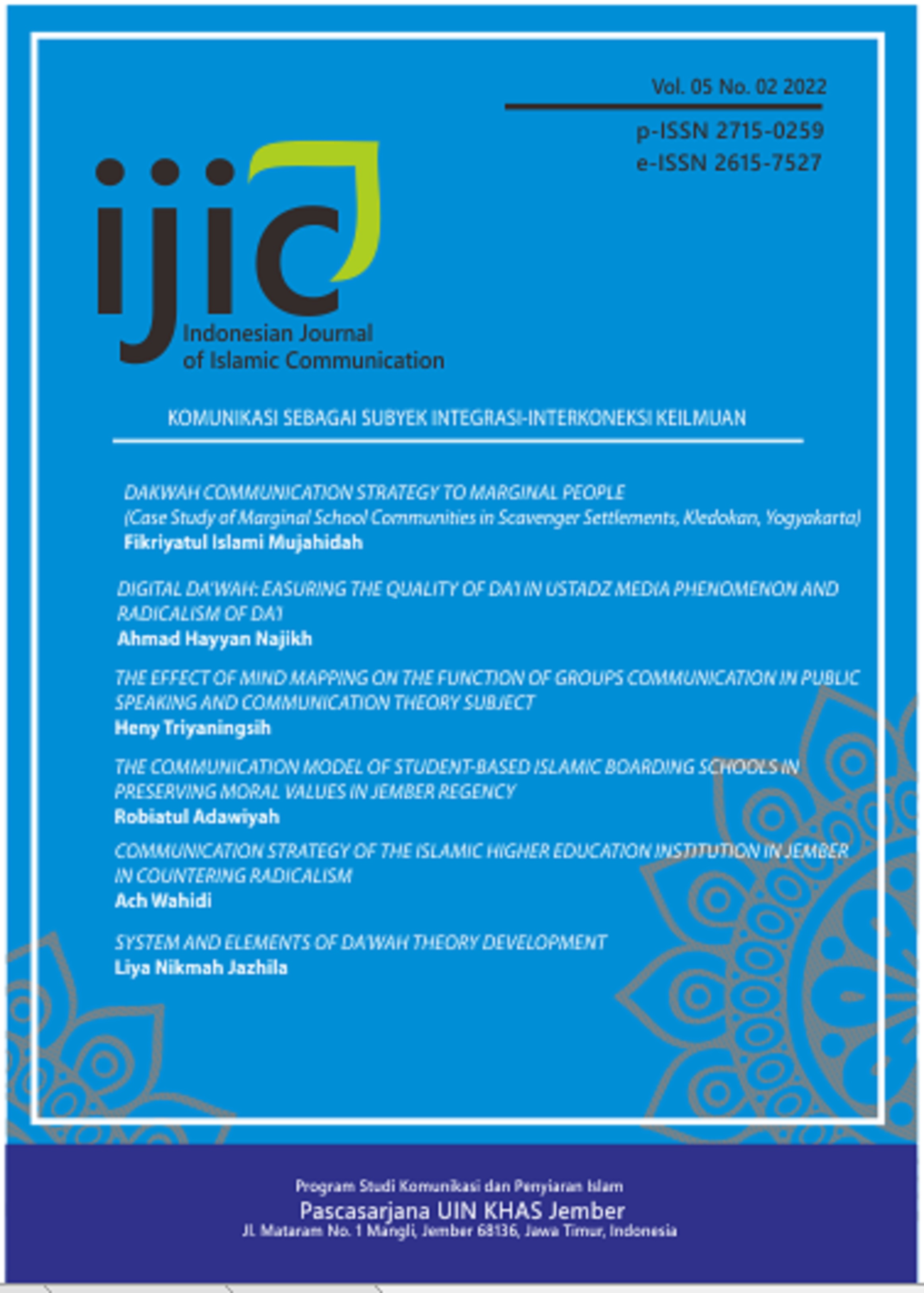THE EFFECT OF MIND MAPPING ON THE FUNCTION OF GROUPS COMMUNICATION IN PUBLIC SPEAKING AND COMMUNICATION THEORY SUBJECT
DOI:
https://doi.org/10.35719/ijic.v5i2.1829Keywords:
group communication, mind mapping, optimalAbstract
The purpose of communication is to change attitudes, opinions, behavior, and social society. In particular, the interaction between lecturers and students normalizes the message to arrive completely and optimally, including in the courses of communication theory and public speaking. Based on these needs, the use of mind mapping is the object of research as a way of optimizing group communication by formulating problems related to the mechanism for making mind maps and their effect on learning in group communication. The method used in this study is descriptive qualitative analysis, namely by observing, collecting and presenting the data to be analyzed. The researcher concluded that the mechanism for making a mind map is to make a concept map on the material presented in class, the lecturer's explanation and discussion. The influence of making mind mapping in the courses of communication theory and public speaking produces a very significant effect, namely based on the percentage of positive responses to the mind mapping and manufacturing stages and the effects on students, more than 75% respond positively compared to the negative effects.
Downloads
References
Buzan. T. 2004. Mind Map: Untuk Meningkatkan Kreativitas. Jakarta: Gramedia Pustaka Utama
Creswell, J. W. (2003). Research Design: Qualitative, Quantitative, and Mixed Methods Approaches. London: Sage Publications
Denzin, N. K dan Lincoln, Y. S. 1998. Introduction: Entering the Field of Kualitatif Research, dalam Handbook of Kualitatif Research. Norman K. Denzin dan Yvonna S. Lincoln (Ed.). Thousand Oaks: Sage.
DePorter, B. 2000. Quantum Learning: Membiasakan Belajar Nyaman dan Menyenangkan. Bandung: Kaifa
Frankel, J R, dkk. 1932. How To Design and Evaluate Research in Education. New York: McGraw-Hill.
Hardjana. 2003. Pengertian sederhana komunikasi efektif
Krathwohl, D. R. 2002. A Revision of Bloom’s Taxonomy: An Overview. Columbus, Ohio, Amerika Serikat: Ohio State University
Moleong J Lexy. 2004. Metode Penelitian Kualitatif (Edisi revisi). PT Remaja Rosdakarya, Bandung
Poerwandari E. Kristi. 1998. Pendekatan Kualitatif dalam penelitian Psikologi. LPSP3 UI
Richard West dan Lynn H.Turner. 2003. Pengantar Teori Komunikasi: Analisis dan Aplikasi
Sanjaya, W. 2006. Strategi Pembelajaran Berorientasi Standar Proses Pendidikan. Jakarta: Kencana
Slameto. 2015. Belajar dan Faktor-Faktor yang Mempengaruhinya. Jakarta: Rineka Cipta
Sudjana, N. 2005. Dasar-dasar Proses Belajar Mengajar. Bandung: Sinar Baru Algensindo
Suyono & Hariyanto. 2015. Implementasi Belajar & Pembelajaran, Bandung: Remaja Rosdakarya
Syaiful Rahim, 2009. Teori Komunikasi: Perspektif, Ragam & Aplikasi, Jakarta: Rineka Cipta
Thobroni, M. 2015. Belajar dan Pembelajaran Teori dan Praktik. Yogyakarta: AR-RUZZ MEDIA
Trianto. 2009. Mendesain Model Pembelajaran Inovatif-Progresif: Konsep, Landasan, dan Implementasinya pada Kurikulum Tingkat Satuan Pendidikan (KTSP). Jakarta: Kencana Prenada Media Group.
Zuhaerini, dkk. 1977. Metode Khusus Pendidikan Agama Islam. Surabaya: Usaha Nasional








